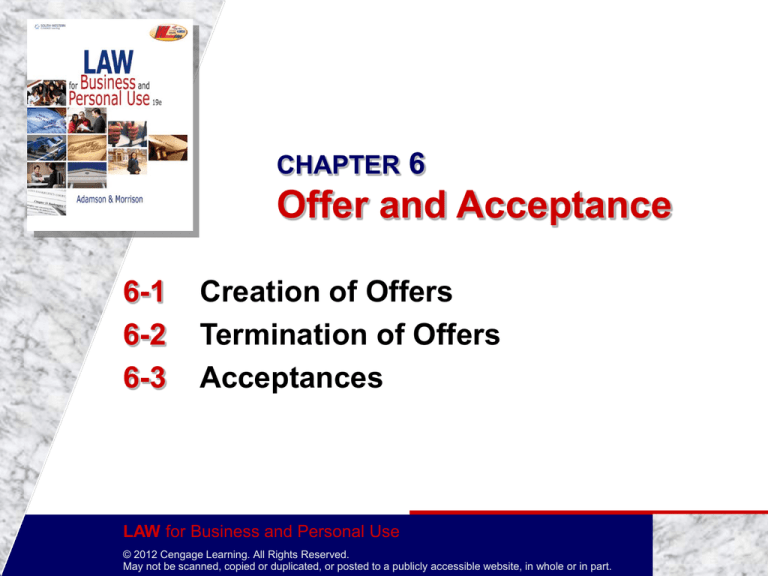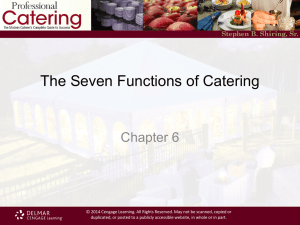
CHAPTER 6
Offer and Acceptance
6-1
6-2
6-3
Creation of Offers
Termination of Offers
Acceptances
LAW for Business and Personal Use
© 2012 Cengage Learning. All Rights Reserved.
May not be scanned, copied or duplicated, or posted to a publicly accessible website, in whole or in part.
6-1
Creation of Offers
GOALS
List the elements required to form a contract
Describe the requirements of an offer
LAW for Business and Personal Use
Chapter 6
© 2012 Cengage Learning. All Rights Reserved.
May not be scanned, copied or duplicated, or posted to a publicly accessible website, in whole or in part.
SLIDE 2
REQUIREMENTS OF A LEGALLY
ENFORCEABLE CONTRACT
1. Offer and acceptance
1. Offeror – the person making the offer
2. Offeree – the person accepting the offer
2.
3.
4.
5.
6.
Genuine assent
Legality
Consideration
Capacity
Proper form
LAW for Business and Personal Use
Chapter 6
© 2012 Cengage Learning. All Rights Reserved.
May not be scanned, copied or duplicated, or posted to a publicly accessible website, in whole or in part.
SLIDE 3
NATURE AND CLASSES OF
CONTRACTS
Executed and executory contracts
Express, implied-in-fact, and implied-at-law
(quasi) contracts
Unilateral and bilateral (multilateral)
contracts
LAW for Business and Personal Use
Chapter 6
© 2012 Cengage Learning. All Rights Reserved.
May not be scanned, copied or duplicated, or posted to a publicly accessible website, in whole or in part.
SLIDE 4
What is it?
I tell my sister I will pay her $100.00 if and
when she paints the fence.
If she promises to do so, is it a bilateral contract
or a unilateral contract.?
It is a unilateral contract because it is
performance based not a promise.
LAW for Business and Personal Use
Chapter 6
© 2012 Cengage Learning. All Rights Reserved.
May not be scanned, copied or duplicated, or posted to a publicly accessible website, in whole or in part.
SLIDE 5
CHECKPOINT
What elements are required to form a legally
enforceable contract?
LAW for Business and Personal Use
Chapter 6
© 2012 Cengage Learning. All Rights Reserved.
May not be scanned, copied or duplicated, or posted to a publicly accessible website, in whole or in part.
SLIDE 6
REQUIREMENTS OF AN OFFER
Contractual intent must be present
Jests
Statements made in anger or terror
Preliminary negotiations
Social agreements
Offer must be communicated to the offeree
Essential terms must be complete and
definite
LAW for Business and Personal Use
Chapter 6
© 2012 Cengage Learning. All Rights Reserved.
May not be scanned, copied or duplicated, or posted to a publicly accessible website, in whole or in part.
SLIDE 7
CHECKPOINT
What are the requirements of an offer?
LAW for Business and Personal Use
Chapter 6
© 2012 Cengage Learning. All Rights Reserved.
May not be scanned, copied or duplicated, or posted to a publicly accessible website, in whole or in part.
SLIDE 8
6-2
Termination of Offers
GOALS
Describe the various ways to end offers
Explain how an offeree can ensure an offer will
remain open
LAW for Business and Personal Use
Chapter 6
© 2012 Cengage Learning. All Rights Reserved.
May not be scanned, copied or duplicated, or posted to a publicly accessible website, in whole or in part.
SLIDE 9
HOW CAN OFFERS BE ENDED?
Revocation by the offeror
Time stated in the offer
Reasonable length of time
Rejection by the offeree
Counteroffer
Death or insanity of either the offeror or
offeree
Destruction of the specific subject matter
LAW for Business and Personal Use
Chapter 6
© 2012 Cengage Learning. All Rights Reserved.
May not be scanned, copied or duplicated, or posted to a publicly accessible website, in whole or in part.
SLIDE 10
CHECKPOINT
Explain two ways in which offers can be
terminated.
Revocation by the offeror
Time stated in the offer
Reasonable length of time
Rejection by the offeree
Counteroffer
Death or insanity of either the offeror or offeree
Destruction of the specific subject matter
LAW for Business and Personal Use
Chapter 6
© 2012 Cengage Learning. All Rights Reserved.
May not be scanned, copied or duplicated, or posted to a publicly accessible website, in whole or in part.
SLIDE 11
HOW CAN AN OFFER BE KEPT
OPEN?
Options
Firm offers
LAW for Business and Personal Use
Chapter 6
© 2012 Cengage Learning. All Rights Reserved.
May not be scanned, copied or duplicated, or posted to a publicly accessible website, in whole or in part.
SLIDE 12
CHECKPOINT
How could an offeree ensure that an offer
will stay open for a set period of time?
LAW for Business and Personal Use
Chapter 6
© 2012 Cengage Learning. All Rights Reserved.
May not be scanned, copied or duplicated, or posted to a publicly accessible website, in whole or in part.
SLIDE 13
6-3
Acceptances
GOALS
Discuss the requirements of an effective
acceptance
Determine at what point in time an acceptance is
effective
LAW for Business and Personal Use
Chapter 6
© 2012 Cengage Learning. All Rights Reserved.
May not be scanned, copied or duplicated, or posted to a publicly accessible website, in whole or in part.
SLIDE 14
WHAT IS REQUIRED OF AN
ACCEPTANCE?
Only offerees may accept
The acceptance must match the offer
Acceptance must be communicated to the
offeror
Silence as acceptance
Promises as acceptance
Performance as acceptance
Modes of contractual communication
When acceptances are effective
LAW for Business and Personal Use
Chapter 6
© 2012 Cengage Learning. All Rights Reserved.
May not be scanned, copied or duplicated, or posted to a publicly accessible website, in whole or in part.
SLIDE 15
CHECKPOINT
What are the requirements of an effective
acceptance?
Only offerees may accept
The acceptance must match the offer
Acceptance must be communicated to the offeror
LAW for Business and Personal Use
Chapter 6
© 2012 Cengage Learning. All Rights Reserved.
May not be scanned, copied or duplicated, or posted to a publicly accessible website, in whole or in part.
SLIDE 16
PREVENT
LEGAL
DIFFICULTIES
When you seek to enter into a contract . . .
When negotiating, assume the worst and include terms in
the contract addressing potential problems.
For important contracts, put offers and acceptances in
writing. If either an offer or an acceptance is made orally,
promptly confirm it in writing.
Obtain and keep a copy of every important document you
sign.
Express your intentions in offers and acceptances with
clear, complete, and understandable language.
Continued on the next slide
LAW for Business and Personal Use
Chapter 6
© 2012 Cengage Learning. All Rights Reserved.
May not be scanned, copied or duplicated, or posted to a publicly accessible website, in whole or in part.
SLIDE 17
PREVENT
LEGAL
DIFFICULTIES
Remember that the offeror may specify how and when the
offer must be accepted. Otherwise the offeree may use the
same means used by the offeror, a faster means, or other
reasonable means.
When appropriate, buy an option, if one is available, to
keep the offer open for as long as you need.
Remember that for an offeror to withdraw or revoke an offer,
the offeree must receive notice. For speed, use the
telephone, e-mail, or fax machine to withdraw or revoke an
offer.
LAW for Business and Personal Use
Chapter 6
© 2012 Cengage Learning. All Rights Reserved.
May not be scanned, copied or duplicated, or posted to a publicly accessible website, in whole or in part.
SLIDE 18








